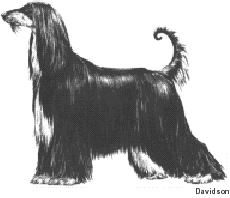Afghan Hound
General Information - Afghan Hound

Group:
Hound
Size:
Large
Lifespan:
12-14 years
Exercise:
Medium
Grooming:
High
Watchdog ability:
High
Protection ability:
Very low
Area of Origin:
Afghanistan
Date of Origin:
Ancient times
Other Names:
Tazi, Baluchi Hound
Original Function:
Coursing hare and gazelle
History
The Afghan Hound's ancestry dates back thousands of years to the greyhound family, although he is most closely connected to the Persian Greyhound. After arriving in Afghanistan from Arabia and Persia, this distinctive dog's coat is thought to have developed in response to the harsher climate. The breed became the Afghani nobility's hunting dog of choice because of its ability to cover rocky terrain with agility, speed and ease. The first Afghans were brought to England in 1894 by soldiers returning from the Afghan and India border. Breeding of the Afghan began in earnest in the early 1920s when two Englishmen imported seventeen more of these dogs. This popular breed is a good family friend when provided with space and plenty of exercise.
Temperament
The adult Afghan hound has a royal bearing and may be aloof and dignified but should never be shy. With his family he can be a clown and very affectionate. They are intelligent watchdogs and do not bark just to make a noise. Training an Afghan hound can be a challenge - they learn very quickly but then have to be convinced that there is a purpose behind what they have learned! Reward training works well with an Afghan hound. They are sight hounds and will chase live game, so off leash exercise should be restricted to safely fenced areas.
Upkeep
The Afghan needs daily exertion, either in the form of a long walk followed by a short sprint, or preferably, a chance to run full speed in a safe, enclosed area. Although its coat might make it amenable to outdoor living in temperate areas, it needs a soft bed and is better suited as a house dog. The coat requires some commitment, especially when shedding the puppy coat; most adult coats need brushing or combing every two to three days.
Afghan Hound
A breed standard is the guideline which describes the ideal characteristics, temperament, and appearance of a breed and ensures that the breed is fit for function with soundness essential. Breeders and judges should at all times be careful to avoid obvious conditions and exaggerations, as well as being mindful of features which could be detrimental in any way to the health, welfare or soundness of this breed.
Breed Standard - Afghan Hound

Characteristics: The Afghan Hound should be dignified and aloof with a certain keen fierceness. The Eastern or Oriental expression is typical of the breed. The Afghan looks at and through one.
General Appearance: The gait of the Afghan Hound should be smooth and springy with a style of high order. The whole appearance of the dog should give the impression of strength and dignity combining speed and power. The head must be held proudly.
Head and Skull:Skull long, not too narrow with prominent occiput. Foreface long with punishing jaws and slight stop. The skull well:balanced and surmounted by a long “top:knot”. Nose preferably black but liver is no fault in light coloured dogs.
Eyes: Should be dark for preference but golden colour is not debarred. Nearly triangular, slanting slightly upwards from the inner corner to the outer.
Ears: Set low and well back, carried close to the head. Covered with long silky hair.
Mouth: Level.
Neck: Long, strong with proud carriage of the head.
Forequarters: Shoulders long and sloping, well:set back, well:muscled and strong without being loaded. Forelegs straight and well:boned, straight with shoulder, elbows held in.
Body: Back level, moderate length, well:muscled, the back falling slightly away to the stern. Loin straight, broad and rather short. Hip:bones rather prominent and wide apart. A fair spring of ribs and good depth of chest.
Hindquarters: Powerful, well:bent and well:turned stifles. Great length between hip and hock with a comparatively short distance between hock and foot. The dew claws may be removed or remain at the discretion of the breeder.
Feet: Forefeet strong and very large both in length and breadth and covered with long thick hair, toes arched. Pasterns long and springy, especially in front and pads well down on the ground. Hindfeet long, but not quite so broad as forefeet, covered with long thick hair.
Tail: Not too short. Set on low with ring at the end. Raised when in action. Sparsely feathered.
Coat: Long and very fine texture on ribs, fore and hindquarters and flanks. From the shoulder backwards and along the saddle the hair should be short and close in mature dogs. Hair long from the forehead backward, with a distinct silky “top:knot”. On the foreface the hair is short as on the back. Ears and legs well coated. Pasterns can be bare. Coat must be allowed to develop naturally.
Colour: All colours are acceptable.
Weight and Size: Ideal height: Dogs 68: 74 cm (27: 29 in). Bitches 5: 8 cm (2:3 in) smaller.
Faults: Any appearance of coarseness. Skull too wide and foreface too short. Weak underjaw. Large round or full eyes. Neck should never be too short or thick. Back too long or too short.
Note: Male animals should have two apparently normal testicles fully descended into the scrotum.
DNZ No 404
Copyright Dogs New Zealand
01 Jan 2002
Any departure from the foregoing points should be considered a fault and the seriousness with which the fault should be regarded should be in exact proportion to its degree and its effect upon the health and welfare of the dog and on the dog’s ability to perform its traditional work.




